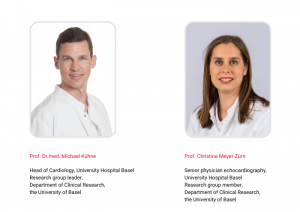Following our interview with Rafał Samborski, CEO at Cardiomatics, we have asked Prof. Michael Kühne and Prof. Christine Meyer-Zürn from the University of Basel to go in depth on the Swiss-AF-Burden project.
Read more about the Swiss-AF-Burden study in the Press Release published here

Christine, tell us what questions are researchers facing in the Swiss-AF-Burden project?
CMZ: In order to adequately allocate health care resources, a better understanding of AF burden and whether it contributes to outcomes are sorely needed. In the Swiss-AF Burden project, we aim to increase our knowledge on the association between AF burden, defined as the percentage of time in AF, and its health consequences, which are mainly stroke/systemic embolism and cognitive dysfunction.
Why did you decide to use an AI-based tool for ECG signal analysis? How does this affect the work of your team?
CMZ: Within Swiss-AF Burden, we measure the AF burden manually from a standard 7-day Holter ECG. The medical-grade system which we are using ensures high-quality and trusted outcomes based on accurate algorithms. This helps us to independently validate our results, especially in patients with multiple AF episodes and noisy recordings, where the manual estimation of the AF burden can be challenging.
How does this change your daily routine regarding work with cloud AI-based digital analyses?
MK: The web-based platform is very simple and user-friendly. After uploading the raw signal of the ECG, we get access to a detailed report within a few hours. In a clinical routine, this can save a lot of time compared to the time-consuming analysis of Holter recordings with conventional Holter software.
How could the final results of the Swiss-AF-Burden study potentially influence the current recommendations for the treatment of atrial fibrillation?
MK: Swiss-AF Burden will provide novel and unique insights into the association between directly measured AF burden and its health consequences, namely stroke. If we can prove that the AF burden has a significant impact on the measured endpoints, the results would recommend specifically using AF burden to determine risk and including the parameter in risk scores and calculators for stroke prediction and potentially for decision making tools regarding oral anticoagulation.
What other areas related to the diagnosis and treatment of atrial fibrillation require urgent investigation?
CMZ: Most recently, new techniques for digital ECG analysis (e.g., machine learning and artificial intelligence) and new technologies to screen and diagnose AF (e.g., wearable devices) have been introduced. These innovations offer us new ways to personalize the treatment of AF and to improve risk stratification in the individual patient. However, studies that assess these opportunities in detail and trials that define which groups of AF patients benefit most are still lacking. With regard to AF treatment, gaps in current knowledge include the role of biomarkers in AF treatment, the use of oral anticoagulation in specific AF patients (e.g., after heart valve therapy, after bleeding or stroke) and various other questions around catheter ablation (e.g., ablation technique, value in preventing AF progression).



